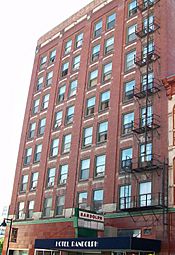Randolph Hotel (Des Moines, Iowa) facts for kids
Quick facts for kids |
|
|
Hotel Randolph
|
|
 |
|
| Location | 200–204 4th St. Des Moines, Iowa |
|---|---|
| Area | <1 acres |
| Built | 1912 |
| Architect | H. L. Stevens Co. |
| NRHP reference No. | 09000403 |
| Added to NRHP | June 11, 2009 |
The Randolph Hotel, also known as Hotel Randolph, is a tall building in Des Moines, Iowa, United States. It has nine stories and was built a long time ago in 1911. The company that designed and built it was called H.L. Stevens & Company.
This hotel is special because it offers rooms for people who want to stay for a longer time. Many guests stay for more than 30 days in a row. You can find the Randolph Hotel in the downtown area of Des Moines. It is on the corner of Fourth Street and Court Avenue, which is a historic part of the city.
History of the Randolph Hotel
The Randolph Hotel was built in 1912. It was one of the first very tall buildings in Des Moines. People at the time said it was the only "absolutely fireproof hotel" in the city. This meant they thought it could not catch fire.
However, even though it was called fireproof, there was a fire at the hotel on February 19, 2010. The hotel is located at 200-204 4th Street. This address is in the main business area of downtown Des Moines.
A Historic Landmark
The Randolph Hotel is an important building in history. Because of its age and design, it was added to the National Register of Historic Places (NRHP). This is a special list of places in the United States that are important to history. The hotel was added to this list on June 11, 2009.
The National Park Service, which manages the list, even featured the Randolph Hotel as a special listing on June 19, 2009. Being on this list helps protect the building.
Future Plans for the Hotel
In 2008, there were plans to fix up the Randolph Hotel. The idea was to turn it into homes that people with lower or middle incomes could afford to rent. To help pay for this work, the project planned to use special money called "historic preservation tax credits." These credits come from the government and help save old buildings.


